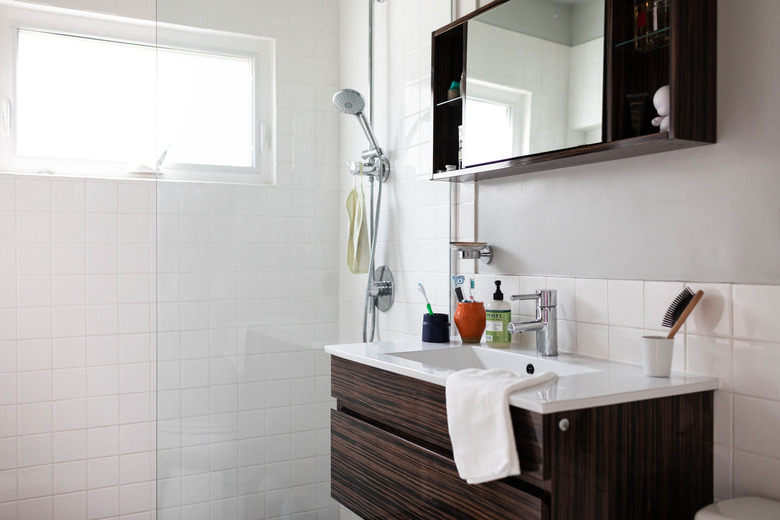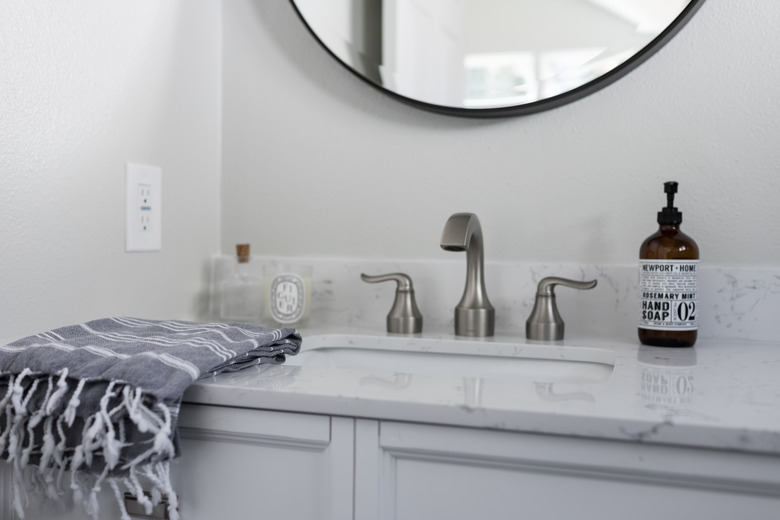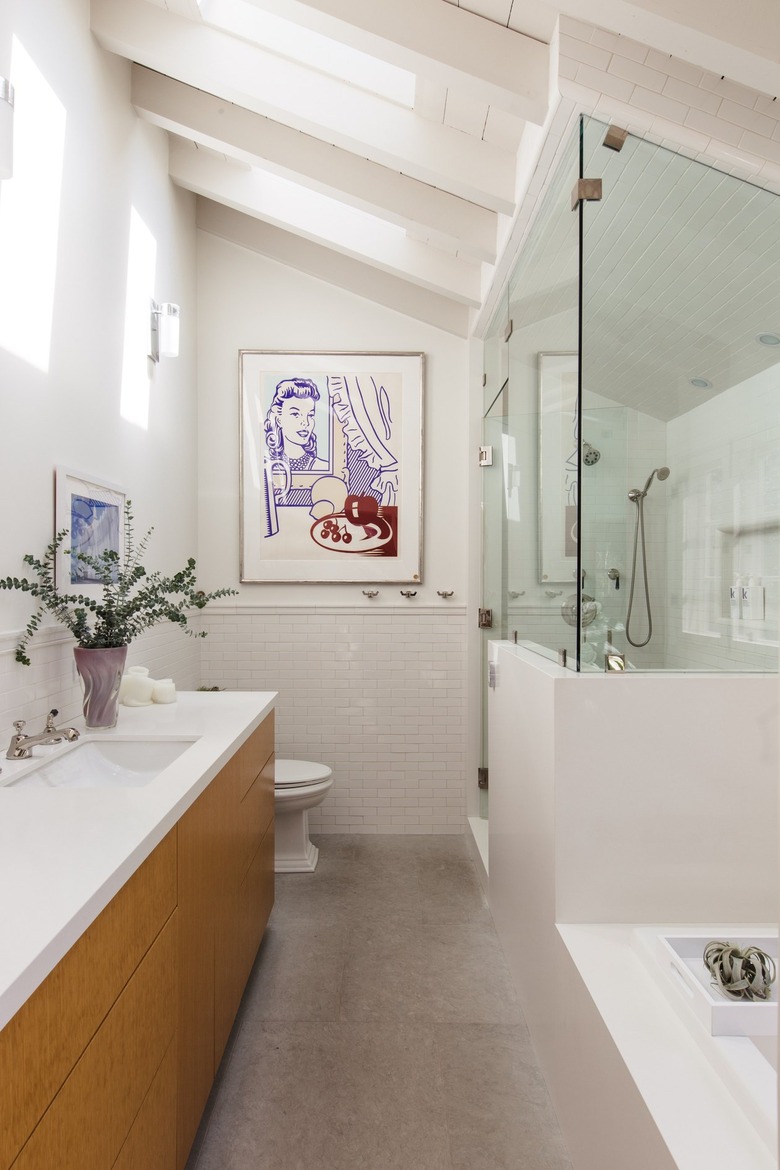Ceramic Vanity Tops: What You Should Know
We may receive a commission on purchases made from links.
Ceramic is one of the most common sink materials, but an increasing trend extends the edges of the sink itself so your counter and sink are made of one piece of solid ceramic. While a ceramic vanity top can be an attractive addition to many homes, there are some factors to consider before deciding on the right vanity top for your bathroom.
Ceramic is made by firing clay in a kiln at high temperatures. While ceramic can take on many different properties based on the types of clay and the temperature of the kiln, the type used to make a ceramic sink has a hard, durable surface that is both easy to clean and fairly resistant to damage, which is why it is one of the most common materials used in the bathroom sink industry.
Ceramic Vanity Top Material Options
Ceramic Vanity Top Material Options
When shopping for a ceramic vanity top, it's common to see ceramic materials that are also called porcelain, vitreous china or fireclay, which can be confusing. In fact, these products are all different types of ceramic that have had additional materials added to enhance the natural benefits of ceramic.
Porcelain is a form of ceramic made by using a very dense clay that is heated to a much higher temperature than most ceramic. Porcelain is denser than typical ceramic and is naturally nonporous, which means it is waterproof, whereas regular ceramic has to be glazed for use as a sink basin.
Vitreous china is made from porcelain, but it is then coated with a glass-powder glaze known as vitreous enamel that is fused to the body. This creates a tough, dense and shiny finish that is particularly hardy and perfect for use as a bathroom vanity top. Vitreous china is resistant to stains, soap scum, chips, burns and other types of damage commonly inflicted on bathroom countertops.
Fireclay is essentially a different type of vitreous china made from a specific type of filtered clay and then topped with a heavy glaze. Some claim that fireclay is more durable than vitreous china, but as StarCraft Custom Builders points out, these claims have not been tested by an independent authority, so it should be taken with a grain of salt.
When it comes to the best material for your ceramic vanity top, generally speaking, you can expect the most durability from vitreous china or fireclay, although generic ceramic or porcelain materials are fine for most homes.
While you might occasionally come across sinks made from porcelain enamel or enamelware, it is worth noting that these are not actually made from ceramic but instead cast iron coated in vitreous enamel. While this is a quality material for a drop-in sink, vessel sink or undermount sink, it is not available for all-in-one sink and vanity tops.
Pros and Cons of Ceramic Vanity Tops
Pros and Cons of Ceramic Vanity Tops
Like all things, there are both benefits and drawbacks to ceramic vanity tops. A few of the biggest advantages include:
- Resistant to damage: All forms of ceramic used in vanity
tops are resistant to chips, stains, soap scum, burns and other common damage. It's
important to remember that they can still be chipped and scratched, though.
Easy to clean: Because ceramic used for sinks is very smooth
and waterproof, it is easy to clean and is resistant to bacteria growth.
Generally, you can clean your counter and sink with nothing more than a wet
sponge and dish soap, making sure to wipe off all soap residue and then drying thoroughly
to avoid soap scum or water stains. For more difficult stains, place a layer of
paper towels over the surface and then spray bleach (or hydrogen peroxide if
your vanity top isn't white) until the towels are thoroughly soaked. Remove the
towels after 30 minutes to an hour and then rinse thoroughly with water before
drying the vanity top. Avoid using abrasives on a ceramic vanity top.
Some things that might make you think twice before buying a vanity top made from ceramic include:
- Limited options: There are only a limited number of styles and colors available. In fact,
while ceramic, porcelain, vitreous china and fireclay all come in an array of
colors, it is difficult to find a ceramic vanity top in any color but white. And while there are many decorative options to choose from, it can be difficult to find a double
vanity top made from ceramic, and when you do, you can expect to pay at least
$1,000.
Susceptible to chips: While ceramic is largely resistant to
damage, with a hard enough hit, it can and will chip or crack. In fact, Consumer Reports says that its tests show these materials are likely to chip if an
object like scissors or nail clippers fall from a medicine cabinet onto the
countertop. You can repair these chips with a porcelain chip fix kit, but it's
best to ensure that anything heavy enough to chip the counter is kept in a cabinet
drawer instead.
Things to Consider Before Buying
Things to Consider Before Buying
There are fewer options available for ceramic vanity tops than there are for other materials. Overall, these vanity tops come in the same range of sizes as other materials, usually 20 to 50 inches for single vanities, though the price increases dramatically as the size goes up. Smaller countertops around 25 inches cost around $100 to $300, which is comparable to the cost of cultured marble. On the other hand, once you get to sizes over 49 inches, prices start at $500, whereas cultured marble in the same size starts at $250, and solid-surface vanity tops start at around $350. You can find ceramic vanity tops at The Home Depot, Build.com, Kohler, and other specialty retailers.
Remember when buying that you should keep in mind what type of faucet you would like to buy, as the counters come pre-fitted with a set number of holes, so you can use either a single-hole or triple-hole faucet.
How to Install a Ceramic Vanity Top
How to Install a Ceramic Vanity Top
Installing a ceramic vanity top is no different than installing any other vanity top and is a fairly simple home improvement project. It is important to follow the manufacturer-provided instructions, as some products may need to be clamped or screwed into the vanity base.
Start by installing your faucet and drain fitting according to the manufacturer instructions. Apply a thin layer of caulk along the top of the vanity cabinet and then carefully lift up the vanity top and set it on the cabinet. If you do not feel comfortable lifting the vanity top, ask a friend to help since it is likely to crack if dropped. Adjust the vanity top until it sits evenly and then wipe away any excess caulk. Connect the drain and faucet to your home plumbing to complete the installation.
References
- Kohler: Installation Guide
- StarCraft Custom Builders: Selecting Bathroom Fixtures
- Consumer Reports: Bathroom Sinks, Traditional to Trendy
- Home Depot: Ceramic Bathroom Vanity Tops
- Wayfair: Ceramic Vanity Tops
- Lowe's: Vitreous China | Bathroom Vanity Tops
- The Toilet Zone: Bathroom Sink Material Buying Guide (Porcelain, Ceramic, Stainless & More)
- Trade Winds Imports: Vitreous China vs Porcelain: What's the Difference?


